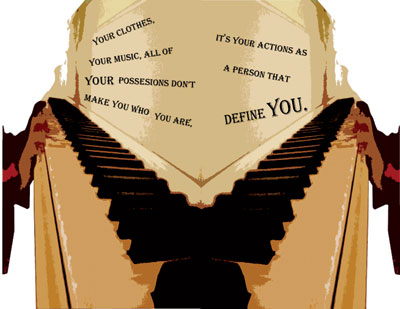All Nonfiction
- Bullying
- Books
- Academic
- Author Interviews
- Celebrity interviews
- College Articles
- College Essays
- Educator of the Year
- Heroes
- Interviews
- Memoir
- Personal Experience
- Sports
- Travel & Culture
All Opinions
- Bullying
- Current Events / Politics
- Discrimination
- Drugs / Alcohol / Smoking
- Entertainment / Celebrities
- Environment
- Love / Relationships
- Movies / Music / TV
- Pop Culture / Trends
- School / College
- Social Issues / Civics
- Spirituality / Religion
- Sports / Hobbies
All Hot Topics
- Bullying
- Community Service
- Environment
- Health
- Letters to the Editor
- Pride & Prejudice
- What Matters
- Back
Summer Guide
- Program Links
- Program Reviews
- Back
College Guide
- College Links
- College Reviews
- College Essays
- College Articles
- Back
Reality vs. Illusion
Our five senses provide us with the ability to experience reality; however, it is our imagination that gives us insight into the far greater and complex aspect of illusion. The world in which we live is perceived through our interpretation of what we see, hear, and perceive through the five senses. The times that the senses are dormant are the times that illusions are created. There are some who believe life is an illusion, but can anyone truly differentiate between the two? This is the question that writer's ask as they twist and concoct their plots of reality mixed with illusion. Hallucination plays a certain role that reveals the protagonist's mental and emotional state. “The Yellow Wallpaper” by Charlotte Perkins-Gilman and “Tell-Tale Heart” by Edgar Allan Poe are explicit examples of how authors divulge into the world of illusion but also stay in touch with reality.
In Poe’s “Tell-Tale Heart”, the narrator is an exquisitely intelligent man. This is recognized in the manner in which the narrator scrutinized and assayed his fascination with the old man’s eye. His split personality lied between illusion and reality which in the end drove him insane. There is said to be a fine line between illusion and reality. This is depicted perfectly in the “Tell-Tale Heart”. The narrator delineated a story in which an old man is murdered simply because his “evil eye” caused his unbelievable agony and disturbed his psyche. The narrator did try to persuade readers that he was normal; however, it is quite evident that the lack of distinction between illusion and reality adequately indicates his insanity. As the story presses on, the narrator receives an unexpected visit from officers of the law. They enter quite jovially which is the reality aspect, but the narrator’s imagination tells him that the men are jeering him because they are aware of his deed. The narrator hears the old man’s heart beating and explains it as such, “My head ached, and I fancied a ringing in my ears…it continued and it became more distinct”. His incompetency to differentiate reality with illusion caused him to confess his vile crime because his conscience weighed heavy. The narrator’s illusions blur his reality.
“The Yellow Wallpaper” also focuses on the aspects of illusion vs. reality, but in this short story illusions were used to escape reality. The narrator uses illusions to protect herself from reality, as she is forced to live isolated in a designated room. This is due to her husband’s refusal to accept her mental disorder; thereby, pretending it did not exist. She was forced to communicate with the outside world through the yellow wallpaper on her wall. She used the wallpaper to elude everyday struggles, one being her depression. No one understood what she was going through except the imaginary woman in the wallpaper. The narrator saw the woman trapped, knowing she needed to be freed from the wallpaper. This woman is symbolic of the narrator herself, who is in need of liberation. The narrator mustered up the courage to rip down the wallpaper thus freeing herself from any previous bondage, her husband, the ignorance of the world, etc. The narrator though previously emotional weak, destroyed her illusions and then was able to grasp reality. Her insanity was aided by the fact that there was no appropriate remedy to deal with her depression. The narrator’s illusion may have given her physical emancipation; however, she was still subjugated to the world of insanity, illusions.
Illusion versus reality forms a significant component of many works of literature including my own: Reality vs. Illusion
My heart is pounding like a drummer
The thought of life always makes me wonder
This body of flesh and bones is going under
The thought of death always makes me think
Are we an illusion or is this reality
Stuck between two parallel dimensions
Searching for answers to these questions
Is life just an illustration
And is God the illustrator
Or is it a demonstration
And me the demonstrator
Or is this life really real
And this reality is what we really feel
Reflections in the mirror
Couldn't reflect our souls any clearer
So what we see reflecting just draws us in nearer
Yet still we can't separate our reality from our illusions
So we keep dreaming and fantasizing until our reality becomes our conclusions.

Similar Articles
JOIN THE DISCUSSION
This article has 1 comment.
